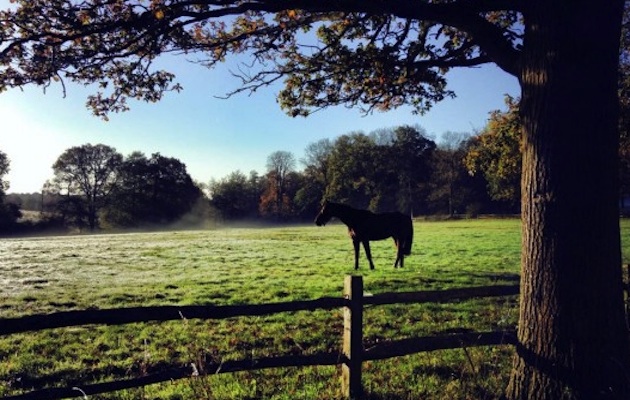The toughest decision is often the kindest with an elderly or infirm horse. Kieran O’Brien MRCVS offers advice on making the hardest call
Recent research found that less than one in 10 horses die of natural causes. For the remainder, a conscious and often agonising decision to end the animal’s life must be made by the owner.
A critical illness, such as incurable colic, or a major irreparable injury will carry an inevitability which eases the decision-making process. In the case of an old or infirm horse who is slowly but progressively declining, however, the call must be made in cold blood.
{"content":"PHA+T2Z0ZW4sIG93bmVycyB3YW50IHVzLCBhcyB2ZXRzLCB0byBudWRnZSB0aGVtIHRvd2FyZHMgYSBjb25jbHVzaW9uLiBUaGlzIGlzIG5vdCBkaWZmaWN1bHQgaWYgdGhlIGhvcnNlIGlzIGNsZWFybHkgc3VmZmVyaW5nLCB5ZXQgaW4gbW9yZSBtYXJnaW5hbCBjYXNlcyBhIGZyYW5rIGNvbnZlcnNhdGlvbiBtdXN0IGJlIGhhZCBpbiB3aGljaCB0b2dldGhlciB3ZSB3ZWlnaCB1cCBhbGwgYXNwZWN0cyBvZiB0aGUgaG9yc2XigJlzIGxpZmUg4oCTIGJvdGggbm93IGFuZCBpbiB0aGUgZnV0dXJlLiA8YSBocmVmPSJodHRwczovL3d3dy5ob3JzZWFuZGhvdW5kLmNvLnVrL3BsdXMvdmV0LWxpYnJhcnkvZXF1aW5lLWV1dGhhbmFzaWEtaG9yc2UtcHV0LWRvd24tNzE4MzA1Ij5FdXRoYW5hc2lhPC9hPiBtYXkgdGhlbiBiZSBkZWNpZGVkIHVwb24gb3IgcG9zdHBvbmVkIHVudGlsIGEgbGF0ZXIgZGF0ZS4gQnV0IHRoZSBob3JzZeKAmXMgd2VsZmFyZSBtdXN0IGNvbWUgZmlyc3Q7IHdoZW4gaGlzIGxpZmUgaXMgYmVjb21pbmcgYSBidXJkZW4sIGl0IGlzIHRpbWUgdG8gYWN0LjwvcD4KPHA+V2UgY2FuIG9iamVjdGl2ZWx5IGFzc2VzcyBhIGhvcnNl4oCZcyBxdWFsaXR5IG9mIGxpZmUgYnkgYXNraW5nIHRoZSBmb2xsb3dpbmcgcXVlc3Rpb25zOjwvcD4KPHVsPgo8bGk+PHN0cm9uZz5JcyBoaXMgbGlmZSByZWFzb25hYmx5IG5vcm1hbD88L3N0cm9uZz4gSGUgbmVlZHMgdG8gYmUgYWJsZSB0byBncmF6ZSBmb3IgbW9zdCBvZiB0aGUgZGF5LCB0byBnZXQgdXAgYW5kIGxpZSBkb3duIHVuYWlkZWQsIGFuZCB0byB3YWxrIGFuZCB0cm90IGVhc2lseSBpbiB0aGUgZmllbGQg4oCTIGluIHRoZSBjb21wYW55IG9mIG90aGVyIGhvcnNlcyB3aG8gYXJlIHJlc3BlY3RmdWwgYW5kIGRvIG5vdCBidWxseSBoaW0uPC9saT4KPGxpPjxzdHJvbmc+SXMgaGUgbWFpbnRhaW5pbmcgYm9keSB3ZWlnaHQ\/PC9zdHJvbmc+IEEgZ2F1bnQsIGFuZ3VsYXIgYXBwZWFyYW5jZSBpcyBvZnRlbiBwYXJ0IG9mIHRoZSBhZ2VpbmcgcHJvY2Vzcy4gSWYgYSBob3JzZSBpcyBjb3JyZWN0bHkgZmVkIGFuZCBwcm92aWRlZCB3aXRoIHJ1Z3Mgb3Igc2hlbHRlciBpbiBjb2xkIHdlYXRoZXIsIGhvd2V2ZXIsIGhlIHNob3VsZCBzdGlsbCBoYXZlIHJlYXNvbmFibGUgZmF0IGFuZCBtdXNjbGUgY292ZXIuRmFpbHVyZSB0byBtYWludGFpbiBib2R5IGNvbmRpdGlvbiBpbiBvbGQgYWdlIHVzdWFsbHkgcmVmbGVjdHMgc2lnbmlmaWNhbnQgZGVudGFsIGRpc2Vhc2UuIFVuZXZlbiwgd29ybiBvdXQgb3IgbWlzc2luZyBjaGVlayB0ZWV0aCBjYW4gbWFrZSBpdCBkaWZmaWN1bHQgZm9yIGEgdmV0ZXJhbiB0byBjaGV3IGhheTsgaW4gc29tZSBjYXNlcywgaGUgbWF5IHN0b3AgZWF0aW5nIGl0IGFsdG9nZXRoZXIuIFN1Y2ggYSBob3JzZSBtYXkgc2hvdyBjeWNsaWNhbCBjaGFuZ2VzIGluIGJvZHkgd2VpZ2h0LCBnYWluaW5nIGNvbmRpdGlvbiBpbiBzdW1tZXIgYW5kIGF1dHVtbiB3aGVuIGdyYXNzIGlzIGVhc2lseSBjaGV3ZWQsIGJ1dCBsb3Npbmcgd2VpZ2h0IG92ZXIgdGhlIHdpbnRlciB3aGlsZSBwcmluY2lwYWxseSBsaXZpbmcgb24gaGF5LlRoZXJlIGFyZSBub3cgbWFueSBzcGVjaWFsIHNvZnQgZmVlZHMgdGhhdCBhbGxvdyBob3JzZXMgd2l0aCBkZW50YWwgZGlzZWFzZSB0byB0aHJpdmUsIGlmIHRoZXkgYXJlIGZlZCBpbiBhIHN1ZmZpY2llbnQgcXVhbnRpdHkgYmFzZWQgb24gbnV0cml0aW9uYWwgYWR2aWNlLiBGYWlsdXJlIHRvIGdhaW4gb3IgZXZlbiBtYWludGFpbiBib2R5IHdlaWdodCwgZGVzcGl0ZSB0aGlzLCBpcyBhbiBvbWlub3VzIHNpZ24gYW5kIG1heSBoZXJhbGQgaXJyZXZlcnNpYmxlIGRlY2xpbmUuCjxwPk90aGVyIGNhdXNlcyBvZiB3ZWlnaHQgbG9zcyBpbiBlbGRlcmx5IGhvcnNlcyBpbmNsdWRlIHBhcmFzaXRpc20gYW5kIEN1c2hpbmfigJlzIGRpc2Vhc2UuIFRoZSBsYXR0ZXIgY2FuIGJlIHRyZWF0ZWQgd2l0aCBtZWRpY2F0aW9uLCBidXQgaW4gc29tZSBjYXNlcyB0aGlzIG1heSBjb3N0IG1vcmUgdGhhbiB0aGUgb3duZXIgaXMgYWJsZSBvciB3aWxsaW5nIHRvIHNwZW5kLjwvcD4KPHA+SW5jdXJhYmxlIGNhbmNlciBhZmZlY3RpbmcgdGhlIGFiZG9tZW4gb3IgY2hlc3QgY2FuIGNhdXNlIHN1YnRsZSBidXQgcHJvZ3Jlc3NpdmUgZGVjbGluZS4gSW4gdGhlIGxhdGVyIHN0YWdlcywgdGhpcyBtYXkgYmUgYWNjb21wYW5pZWQgYnkgb3RoZXIgc2lnbnMgc3VjaCBhcyBjb3VnaGluZywgbG9vc2UgZmFlY2VzIG9yIHJlY3VycmVudCBjb2xpYy48L3A+CjwvbGk+CjxsaT48c3Ryb25nPklzIGhlIGluIHBhaW4\/PC9zdHJvbmc+IEFsdGhvdWdoIOKAnHN0aWZmbmVzc+KAnSBpcyByZWdhcmRlZCBieSBtYW55IG93bmVycyBhcyBhIGJlbmlnbiBhbmQgaW5ldml0YWJsZSBjb25zZXF1ZW5jZSBvZiBvbGQgYWdlLCBtb3N0IGVsZGVybHkgaG9yc2VzIGFyZSBzdGlmZiBiZWNhdXNlIHRoZXkgaGF2ZSBqb2ludCBwYWluLiBDb25zZXF1ZW50bHksIG1hbnkgc2hvdyBhIGxpZmUtY2hhbmdpbmcgaW1wcm92ZW1lbnQgd2hlbiBnaXZlbiBwYWlua2lsbGVycyBzdWNoIGFzIHBoZW55bGJ1dGF6b25lIChidXRlKS5TaWducyBvZiBhcnRocml0aXMgaW4gYW4gb2xkZXIgaG9yc2UgaW5jbHVkZSB2YXJpYWJsZSBsYW1lbmVzcywgYSByZWx1Y3RhbmNlIHRvIGhhdmUgaGlzIGZlZXQgaGVsZCB1cCBieSB0aGUgZmFycmllciwgdW53aWxsaW5nbmVzcyB0byBsaWUgZG93biBhbmQgZGlmZmljdWx0eSBpbiByaXNpbmcgYWZ0ZXIgcGVyaW9kcyBvZiByZWN1bWJlbmN5LiBUaGVzZSBhcmUgb2Z0ZW4gbW9yZSBvYnZpb3VzIGluIHRoZSB3aW50ZXIgbW9udGhzLCB3aGVuIGFuIGFydGhyaXRpYyBob3JzZSBpcyB0eXBpY2FsbHkgbGVzcyBhY3RpdmUg4oCTIHN0YW5kaW5nIGltbW9iaWxlIHdoaWxlIHNoZWx0ZXJpbmcgZnJvbSB3aW5kIGFuZCByYWluIG9yIGVhdGluZyBoYXkgd2hpbGUgYXQgcGFzdHVyZSwgYW5kIHN0YWJsZWQgZm9yIHBhcnQgb2YgdGhlIGRheS4gSWYgaGUgaXMgc3RpbGwgYmVpbmcgcmlkZGVuLCBzaG9ydCBkYXlzIGFuZCBiYWQgd2VhdGhlciBjYW4gbWVhbiBsZXNzIGV4ZXJjaXNlLkFydGhyaXRpcyBpcyBhIHByb2dyZXNzaXZlIGRpc2Vhc2UgYW5kIHBoeXNpY2FsIGlzc3VlcyBtYXkgZXZlbnR1YWxseSByZXNwb25kIHBvb3JseSB0byBtZWRpY2F0aW9uLiBSZXBlYXRlZCBkaWZmaWN1bHR5IGluIHN0YW5kaW5nIHVwIHNob3VsZCBwcm9tcHQgdXJnZW50IGNvbnNpZGVyYXRpb24gb2YgZW5kaW5nIHRoZSBob3JzZeKAmXMgbGlmZS4gSWYgaWdub3JlZCwgaGUgbWF5IGJlIGZvdW5kIHVuYWJsZSB0byBzdGFuZCBhZnRlciBhIGxvbmcsIHBhaW5mdWwgc3RydWdnbGUgYW5kIG11c3QgYmUgZXV0aGFuaXNlZCBpbiBzaXR1LjwvbGk+CjwvdWw+CjxwPjxkaXYgY2xhc3M9ImFkLWNvbnRhaW5lciBhZC1jb250YWluZXItLW1vYmlsZSI+PGRpdiBpZD0icG9zdC1pbmxpbmUtMiIgY2xhc3M9ImlwYy1hZHZlcnQiPjwvZGl2PjwvZGl2PjxzZWN0aW9uIGlkPSJlbWJlZF9jb2RlLTMxIiBjbGFzcz0iaGlkZGVuLW1kIGhpZGRlbi1sZyBzLWNvbnRhaW5lciBzdGlja3ktYW5jaG9yIGhpZGUtd2lkZ2V0LXRpdGxlIHdpZGdldF9lbWJlZF9jb2RlIHByZW1pdW1faW5saW5lXzIiPjxzZWN0aW9uIGNsYXNzPSJzLWNvbnRhaW5lciBsaXN0aW5nLS1zaW5nbGUgbGlzdGluZy0tc2luZ2xlLXNoYXJldGhyb3VnaCBpbWFnZS1hc3BlY3QtbGFuZHNjYXBlIGRlZmF1bHQgc2hhcmV0aHJvdWdoLWFkIHNoYXJldGhyb3VnaC1hZC1oaWRkZW4iPg0KICA8ZGl2IGNsYXNzPSJzLWNvbnRhaW5lcl9faW5uZXIiPg0KICAgIDx1bD4NCiAgICAgIDxsaSBpZD0ibmF0aXZlLWNvbnRlbnQtbW9iaWxlIiBjbGFzcz0ibGlzdGluZy1pdGVtIj4NCiAgICAgIDwvbGk+DQogICAgPC91bD4NCiAgPC9kaXY+DQo8L3NlY3Rpb24+PC9zZWN0aW9uPjwvcD4KPGgzPkEgcGVhY2VmdWwgZW5kPC9oMz4KPHA+VGhlIHRlcm0g4oCcZXV0aGFuYXNpYeKAnSBkZXJpdmVzIGZyb20gdGhlIEdyZWVrIHdvcmRzIGZvciDigJxhIGdvb2QgZGVhdGjigJ0sIHNpbmNlIGl0IGJyaW5ncyByZWxpZWYgZnJvbSBwYWluIGFuZCBpcyBjYXJyaWVkIG91dCBpbiBhIHdheSB0aGF0IGRvZXMgbm90IGluIGl0c2VsZiBjYXVzZSBhZGRpdGlvbmFsIGRpc3RyZXNzLiBIb3JzZXMgYXJlIDxhIGhyZWY9Imh0dHBzOi8vd3d3LmhvcnNlYW5kaG91bmQuY28udWsvcGx1cy92ZXQtbGlicmFyeS9lcXVpbmUtZXV0aGFuYXNpYS1ob3JzZS1wdXQtZG93bi03MTgzMDUiPmh1bWFuZWx5IGRlc3Ryb3llZDwvYT4gYnkgc2hvb3RpbmcsIG9yIG1vcmUgY29tbW9ubHkgbm93YWRheXMgYnkgbGV0aGFsIGluamVjdGlvbi4gQSB2ZXQgbWF5IGdpdmUgdGhlIGhvcnNlIGxpZ2h0IHNlZGF0aW9uIHRvIGFsbGF5IGFueSBzdHJlc3MuPC9wPgo8cD5TaG9vdGluZyBpcyBoaWdobHkgZWZmZWN0aXZlIGlmIGRvbmUgc2tpbGZ1bGx5IChieSBhIHZldCwgaHVudCBrZW5uZWxtYW4gb3Iga25hY2tlcm1hbiwgd2l0aCBhIGZpcmVhcm1zIGxpY2VuY2UpIGFuZCBkZWF0aCBpcyBpbnN0YW50YW5lb3VzLCBhbHRob3VnaCB0aGVyZSBtYXkgYmUgc2lnbmlmaWNhbnQgYmxlZWRpbmcgZnJvbSB0aGUgbm9zdHJpbHMuIFRoZSBsZXRoYWwgaW5qZWN0aW9uIG1vc3QgY29tbW9ubHkgdXNlZCBpcyBhIGNvbWJpbmF0aW9uIG9mIGFuIGFuYWVzdGhldGljIGFuZCBhIGRydWcgdGhhdCBjYXVzZXMgY2FyZGlhYyBhcnJlc3QuIFRoZSBwcm9jZXNzIGlzIHNsb3dlciBhbmQgbGVzcyB0cmF1bWF0aWMgdG8gd2l0bmVzcy4gVGhlIGhvcnNlIHNpbmtzIHRvIHRoZSBncm91bmQgdW5jb25zY2lvdXMgYWZ0ZXIgYWJvdXQgMzAgc2Vjb25kcywgYW5kIHdpdGhpbiBhIGZ1cnRoZXIgdHdvIG1pbnV0ZXMgaGlzIGhlYXJ0IHdpbGwgc3RvcCDigJMgZW5hYmxpbmcgdGhlIG93bmVyIHRvIGdpdmUgaGltIGEgZmluYWwgaHVnIGFuZCBzYXkgYSBmZXcgd29yZHMgb2YgZmFyZXdlbGwuPC9wPgo8cD5JdCBpcyB1bmRlcnN0YW5kYWJsZSB0byBmZWVsIGFwcHJlaGVuc2l2ZSBhYm91dCBiZWluZyBwcmVzZW50LiBTaW5jZSB0aGlzIGFueGlldHkgbWF5IGJlIGNvbW11bmljYXRlZCB0byB0aGUgaG9yc2UsIGl0IG1heSBiZSB3aXNlIHRvIHNheSBnb29kYnllIGJlZm9yZWhhbmQgYW5kIHRoZW4gZGVwYXJ0LCBsZWF2aW5nIGEgdHJ1c3RlZCBmcmllbmQgdG8gYXNzaXN0LjwvcD4KPGRpdiBjbGFzcz0iYWQtY29udGFpbmVyIGFkLWNvbnRhaW5lci0tbW9iaWxlIj48ZGl2IGlkPSJwb3N0LWlubGluZS0zIiBjbGFzcz0iaXBjLWFkdmVydCI+PC9kaXY+PC9kaXY+CjxwPklmIHRoZSBob3JzZSB3YXMgY2xvc2VseSBib25kZWQgaW4gYSBwYWlyLCBhbGxvdyB0aGUgcmVtYWluaW5nIGNvbXBhbmlvbiB0byBhcHByb2FjaCBhbmQgc25pZmYgdGhlIGRlYWQgYm9keSwgd2hlcmUgcHJhY3RpY2FsLCBsZWF2aW5nIGhpbSB0byBzcGVuZCB0aW1lIHdpdGggaXQgaWYgaGUgd2lzaGVzLiBXaGlsZSBzb21lIGJlcmVhdmVkIGhvcnNlcyB3aWxsIHRoZW4gaGFwcGlseSBsZWFkIGEgc29saXRhcnkgbGlmZSwgb3RoZXJzIHdpbGwgcmVxdWlyZSBhIG5ldyBmcmllbmQuIElkZWFsbHksIGludHJvZHVjZSBhIGNvbXBhbmlvbiB0byB0aGUgcGFpciBhIHdlZWsgb3IgdHdvIGJlZm9yZWhhbmQgc28gdGhhdCB0aGUgdGhyZWUgZm9ybSB0aGVpciBvd24gaGVyZC48L3A+CjxoMz5QbGFubmluZyBhaGVhZDwvaDM+CjxwPk1ha2luZyBhIGV1dGhhbmFzaWEgcGxhbiB3ZWxsIGluIGFkdmFuY2Ugd2lsbCBlYXNlIHRoZSBlbW90aW9uYWwgYnVyZGVuIHdoZW4gdGhlIHRpbWUgZXZlbnR1YWxseSBjb21lcy4gVGFsayB0byB5b3VyIHZldCBhYm91dCB0aGUgdGVjaG5pcXVlIGFuZCBpdHMgaW1wbGljYXRpb25zLCBhbmQgY29uc2lkZXIgZGlzcG9zYWwgb2YgdGhlIGJvZHkgYW5kIHRoZSBhc3NvY2lhdGVkIGNvc3RzLjwvcD4KPGRpdiBjbGFzcz0iYWQtY29udGFpbmVyIGFkLWNvbnRhaW5lci0tbW9iaWxlIj48ZGl2IGlkPSJwb3N0LWlubGluZS00IiBjbGFzcz0iaXBjLWFkdmVydCI+PC9kaXY+PC9kaXY+CjxwPllvdSBtYXkgZGVjaWRlIHRoYXQgdGhlIGJvZHkgd2lsbCBiZSB0YWtlbiBhd2F5IGJ5IGZhbGxlbiBzdG9jayBvcGVyYXRvcnMsIGZvciByZW5kZXJpbmcgb3IgaW5jaW5lcmF0aW9uLCBvciB0byB1c2UgYSBodW50IHRoYXQgb2ZmZXJzIGEgY2FzdWFsdHkgcmVjb3Zlcnkgc2VydmljZS4gU29tZSBvd25lcnMgYXJyYW5nZSB0byBrZWVwIGFsbCBvciBwYXJ0IG9mIHRoZSBhc2hlcyBvciB0byBidXJ5IHRoZSBob3JzZSBvbiBwcml2YXRlIGxhbmQsIHdoZXJlIGxlZ2lzbGF0aW9uIHBlcm1pdHMuIFJlc2VhcmNoIHRoZSBvcHRpb25zIHNvIHRoYXQgeW91IHVuZGVyc3RhbmQgdGhlIGxvZ2lzdGljcyBpbnZvbHZlZCBhbmQgY2FuIGJ1ZGdldCBhY2NvcmRpbmdseS48L3A+CjxwPk1hbnkgb2YgdXMgZm9ybSBwYXJ0aWN1bGFybHkgc3Ryb25nIGJvbmRzIHdpdGggb3VyIHRyZWFzdXJlZCBjb21wYW5pb25zIGFuZCBhcmUgaGVhcnRicm9rZW4gd2hlbiB3ZSBsb3NlIHRoZW0uIFdoZXRoZXIgdGhlIGVuZCBjb21lcyBzdWRkZW5seSwgb3IgYWZ0ZXIgc29tZSBkaWZmaWN1bHQgZGVjaXNpb24tbWFraW5nLCBiZWluZyBwcmVwYXJlZCB3aWxsIG1ha2UgaXQgZWFzaWVyIHRvIGdpdmUgeW91ciBob3JzZSB0aGUgZ29vZCBkZWF0aCB0aGF0IGhlIGRlc2VydmVzLjwvcD4KPGRpdiBjbGFzcz0iYWQtY29udGFpbmVyIGFkLWNvbnRhaW5lci0tbW9iaWxlIj48ZGl2IGlkPSJwb3N0LWlubGluZS01IiBjbGFzcz0iaXBjLWFkdmVydCI+PC9kaXY+PC9kaXY+CjxoMz5PbmUgd2ludGVyIHRvbyBtYW55PzwvaDM+CjxwPlRoZSBjb2xkZXIgbW9udGhzIGNhbiBiZSBlc3BlY2lhbGx5IGNoYWxsZW5naW5nIGZvciB0aGUgcmV0aXJlZCBob3JzZS4gU2luY2UgcmVjb2duaXNpbmcgYSBkZWNsaW5lIGluIGFuIGFuaW1hbOKAmXMgY29uZGl0aW9uIGNhbiBiZSBkaWZmaWN1bHQgd2hlbiB5b3Ugc2VlIGhpbSBvbiBhIGRhaWx5IGJhc2lzLCBpdCBtYXkgYmUgd2lzZSB0byBhc2sgYSB2ZXQgb3IgYW4gZXhwZXJpZW5jZWQgZnJpZW5kIGZvciBhbiBvYmplY3RpdmUgb3BpbmlvbiBvbiBoaXMgcXVhbGl0eSBvZiBsaWZlIGFuZCB3aGV0aGVyIGl0IGlzIGZhaXIgdG8gcHV0IGEgaGltIHRocm91Z2ggYW5vdGhlciB3aW50ZXIuPC9wPgo8cD5JZiBpdCBpcyB0aW1lIGZvciBhIGRpZ25pZmllZCBlbmQsIGl0IGlzIHZpdGFsIHRoYXQgYSBob3JzZSBpcyBmb3JtYWxseSBpZGVudGlmaWVkIHByaW9yIHRvIGV1dGhhbmFzaWEuIEhpcyBwYXNzcG9ydCBhbmQgbWljcm9jaGlwIHNob3VsZCBiZSBjaGVja2VkIGJ5IHRoZSB2ZXQgYW5kIGEgY29uc2VudCBmb3JtIHNpZ25lZCBieSB0aGUgb3duZXIuPC9wPgo8ZGl2IGNsYXNzPSJpbmplY3Rpb24iPjwvZGl2Pgo8cD5BbnkgaG9yc2UgZGVzdHJveWVkIG9uIGh1bWFuZSBncm91bmRzIG11c3QgbWVldCBjZXJ0YWluIGNyaXRlcmlhIHRvIHNhdGlzZnkgdGhlIHJlcXVpcmVtZW50cyBvZiBhIG1vcnRhbGl0eSBpbnN1cmFuY2UgcG9saWN5LiBDb250YWN0IHlvdXIgaW5zdXJhbmNlIGNvbXBhbnkgaW4gYWR2YW5jZTsgdGhleSBtYXkgYXNrIGZvciB2ZXRlcmluYXJ5IGNvbmZpcm1hdGlvbiBvZiBoaXMgaWRlbnRpdHkgYW5kIHRoZSByZWFzb24gZm9yIGV1dGhhbmFzaWEsIGFuZCwgaW4gc29tZSBjYXNlcywgYSBwb3N0IG1vcnRlbS48L3A+CjxwPkhlbHAgaXMgYXQgaGFuZCBpZiB5b3UgbmVlZCBhZHZpY2UgYW5kIHN1cHBvcnQuIDxhIGhyZWY9Imh0dHBzOi8vd3d3LndvcmxkaG9yc2V3ZWxmYXJlLm9yZy8iIHRhcmdldD0iX2JsYW5rIiByZWw9Im5vb3BlbmVyIG5vcmVmZXJyZXIiPldvcmxkIEhvcnNlIFdlbGZhcmU8L2E+IG9mZmVycyBhIEp1c3QgSW4gQ2FzZSBpbmZvcm1hdGlvbiBwYWNrIGFuZCBhbiBlbmQtb2YtbGlmZSBoZWxwbGluZSwgd2hpbGUgdGhlPGEgaHJlZj0iaHR0cHM6Ly93d3cuYmhzLm9yZy51ay8iIHRhcmdldD0iX2JsYW5rIiByZWw9Im5vb3BlbmVyIG5vcmVmZXJyZXIiPiBCcml0aXNoIEhvcnNlIFNvY2lldHk8L2E+IEZyaWVuZHMgQXQgVGhlIEVuZCBpbml0aWF0aXZlIGNhbiBwdXQgeW91IGluIHRvdWNoIHdpdGggYSB0cmFpbmVkIHZvbHVudGVlciB0byBhc3Npc3QgeW91IHRocm91Z2ggdGhlIHByb2Nlc3MuPC9wPgo8cD48ZW0+UmVmIEhvcnNlICZhbXA7IEhvdW5kOyA4IE9jdG9iZXIgMjAyMDwvZW0+PC9wPgo8cD4K"}
This site is protected by reCAPTCHA and the Google Privacy Policy and Terms of Service apply.
